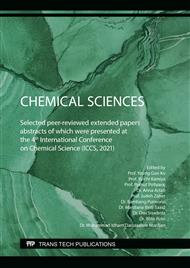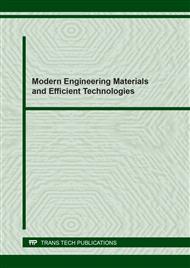[1]
Rusydi, A. F., Suherman, D., & Sumawijaya, N. (2017). Pengolahan Air Limbah Tekstil Melalui Proses Koagulasi – Flokulasi Dengan Menggunakan Lempung Sebagai Penyumbang Partikel Tersuspensi Studi Kasus : Banaran , Sukoharjo Dan Lawean , Kerto Suro , Jawa Tengah. Arena Tekstil, 31(2), 105–114.
DOI: 10.31266/at.v31i2.1671
Google Scholar
[2]
Naimah, S., A., S. A., Jati, B. N., Aidha, N. N., & Cahyaningtyas, A. A. (2014). Degradasi Zat Warna Pada Limbah Cair Industri Tekstil Dengan Metode Fotokatalitik Menggunakan Nanokomposit Tio2 – Zeolit. Jurnal Kimia Dan Kemasan, 36(2), 225. https://doi.org/10.24817/jkk.v36i2.1889.
DOI: 10.24817/jkk.v36i2.1889
Google Scholar
[3]
Putra, S. E., Khairuddin, Puspitasari, D. J., & Sosidi, H. (2019). Pemanfaatan Karbon Aktif Ampas Tahu Teraktivasi NaCl Sebagai Penyerap Zat Warna Congo Red. KOVALEN: Jurnal Riset Kimia, 5(1), 109–115. https://doi.org/10.22487/kovalen.2019.v5.i1.11474.
DOI: 10.22487/kovalen.2019.v5.i1.11474
Google Scholar
[4]
Shetti, N. P., Malode, S. J., Malladi, R. S., Nargund, S. L., Shukla, S. S., & Aminabhavi, T. M. (2019). Electrochemical detection and degradation of textile dye Congo red at graphene oxide modified electrode. Microchemical Journal, 146(January), 387–392. https://doi.org/10.1016/j.microc.2019.01.033.
DOI: 10.1016/j.microc.2019.01.033
Google Scholar
[5]
Nassar, M. Y., Abdelrahman, E. A., Aly, A. A., & Mohamed, T. Y. (2017). A facile synthesis of mordenite zeolite nanostructures for efficient bleaching of crude soybean oil and removal of methylene blue dye from aqueous media. Journal of Molecular Liquids, 248, 302–313. https://doi.org/10.1016/j.molliq.2017.10.061.
DOI: 10.1016/j.molliq.2017.10.061
Google Scholar
[6]
Arora, C., Soni, S., Sahu, S., Mittal, J., Kumar, P., & Bajpai, P. K. (2019). Iron based metal organic framework for efficient removal of methylene blue dye from industrial waste. Journal of Molecular Liquids, 284, 343–352. https://doi.org/10.1016/j.molliq.2019.04.012.
DOI: 10.1016/j.molliq.2019.04.012
Google Scholar
[7]
Fayazi, M., Taher, M. A., Afzali, D., & Mostafavi, A. (2016). Enhanced Fenton-like degradation of methylene blue by magnetically activated carbon/hydrogen peroxide with hydroxylamine as Fenton enhancer. Journal of Molecular Liquids, 216, 781–787. https://doi.org/10.1016/j.molliq. 2016.01.093.
DOI: 10.1016/j.molliq.2016.01.093
Google Scholar
[8]
Değermenci, G. D., Değermenci, N., Ayvaoğlu, V., Durmaz, E., Çakır, D., & Akan, E. (2019). Adsorption of Reactive Dyes on Lignocellulosic Waste; Characterization, Equilibrium, Kinetic and Thermodynamic Studies. Journal of Cleaner Production, 225, 1220–1229. https://doi.org/10.1016/j.jclepro.2019.03.260.
DOI: 10.1016/j.jclepro.2019.03.260
Google Scholar
[9]
Lafi, R., Charradi, K., Amine, M., Ben, A., Amara, H., & Hafiane, A. (2016). Adsorption study of Congo red dye from aqueous solution to Mg – Al – layered double hydroxide. Advanced Powder Technology, 27(1), 232–237. https://doi.org/10.1016/j.apt.2015.12.004.
DOI: 10.1016/j.apt.2015.12.004
Google Scholar
[10]
Ristianingsih, Y., Istiani, A., & Irfandy, F. (2020). Kesetimbangan Adsorbsi Zat Warna Metilen Blue dengan Adsorben Karbon Aktif Tongkol Jagung Terimpregnasi Fe2O3. Jurnal Teknologi Agro-Industri, 7(1), 47–55.
DOI: 10.34128/jtai.v7i1.115
Google Scholar
[11]
Fatriani, Sunardi, & Prayudi, F. (2012). Pengaruh Umur Pohon Aren (Arengan pinnata MERR) Terhadap Produksi Nira di Desa Pulantan Kecamatan Awayan Kabupaten Balangan Provinsi Kalimanan Selatan. Jurnal Hutan Tropis, 13(1), 11–17.
DOI: 10.31602/zmip.v45i2.3039
Google Scholar
[12]
Wijoyo, W., Nurhidayat, A., & Purnomo, C. (2011). Kajian Pengaruh Fraksi Volume Serat Akibat Perlakuan Alkali Terhadap Ketangguhan Impak Komposit Limbah Serat Aren-Polyester. Dinamika Teknik Mesin, 1(2). https://doi.org/10.29303/d.v1i2.116.
DOI: 10.29303/d.v1i2.116
Google Scholar
[13]
Ilyas, R. A., Sapuan, S. M., & Ishak, M. R. (2018). Isolation and characterization of nanocrystalline cellulose from sugar palm fibres (Arenga Pinnata). Carbohydrate Polymers, 181(October 2017), 1038–1051. https://doi.org/10.1016/j.carbpol.2017.11.045.
DOI: 10.1016/j.carbpol.2017.11.045
Google Scholar
[14]
Ishak, M. R., Sapuan, S. M., Leman, Z., Rahman, M. Z. A., Anwar, U. M. K., & Siregar, J. P. (2013). Sugar palm (Arenga pinnata): Its fibres, polymers and composites. Carbohydrate Polymers, 91(2), 699–710. https://doi.org/10.1016/j.carbpol.2012.07.073.
DOI: 10.1016/j.carbpol.2012.07.073
Google Scholar
[15]
Sonia, A., & Dasan, K. P. (2013). Chemical, Morphology and Thermal Evaluation of Cellulose Microfibers Obtained from Hibiscus sabdariffa. Carbohydrate Polymers, 92(1), 668–674. https://doi.org/10.1016/j.carbpol.2012.09.015.
DOI: 10.1016/j.carbpol.2012.09.015
Google Scholar
[16]
Serrano, L., Urruzola, I., Nemeth, D., Bela, K., & Labidi, J. (2011). Modified Cellulose Microfibrils as Benzene Adsorbent. Desalination, 270, 143–150. https://doi.org/10.1016/j.desal.2010.11.038.
DOI: 10.1016/j.desal.2010.11.038
Google Scholar
[17]
Abukhadra, M. R., Adlii, A., & Bakry, B. M. (2019). Green Fabrication of Bentonite/ Chitosan@Cobalt Oxide Composite (BE/CH@Co) of Enhanced Adsorption and Advanced Oxidation Removal of Congo Red Dye and Cr (VI) from Water. International Journal of Biological Macromolecules, 126, 402–413. https://doi.org/10.1016/j.ijbiomac.2018.12.225.
DOI: 10.1016/j.ijbiomac.2018.12.225
Google Scholar
[18]
Chandra, J., George, N., & Narayanankutty, S. K. (2016). Isolation and Characterization of Cellulose Nanofibrils from Arecanut Husk Fibre. Carbohydrate Polymers, 142, 158–166. http://dx.doi.org/10.1016/j.carbpol.2016.01.015.
DOI: 10.1016/j.carbpol.2016.01.015
Google Scholar
[19]
Tang, C., Wang, C., & Chien, S. (2008). Characterization of Cobalt Oxides Studied by FT-IR , Raman, TPR and TG-MS. Thermochimica Acta, 473, 68–73. https://doi.org/10.1016/j.tca. 2008.04.015.
DOI: 10.1016/j.tca.2008.04.015
Google Scholar
[20]
Wang, Y., Wang, X. J., Liu, M., Wang, X., Wu, Z., Yang, L. Z., Xia, S. Q., & Zhao, J. F. (2012). Cr ( VI ) removal from water using cobalt-coated bamboo charcoal prepared with microwave heating. 39, 81–88. https://doi.org/10.1016/j.indcrop.2012.02.015.
DOI: 10.1016/j.indcrop.2012.02.015
Google Scholar
[21]
Kumar, R., Kumari, S., Rai, B., Kumar, R., Sirohi, S., & Kumar, G. (2020). A Facile Chemical Approach to Isolate Cellulose Nanofibers from Jute Fibers. Journal of Polymers and the Environment, 28(10), 2761–2770. https://doi.org/10.1007/s10924-020-01808-6.
DOI: 10.1007/s10924-020-01808-6
Google Scholar
[22]
George, G., & Anandhan, S. (2016). Tuning Characteristics of Co3O4 Nanofiber Mats Developed for Electrochemical Sensing of Glucose and H2O2. Thin Solid Films, 610, 48–57. https://doi.org/10.1016/j.tsf.2016.05.005.
DOI: 10.1016/j.tsf.2016.05.005
Google Scholar
[23]
Manigandan, R., Giribabu, K., Suresh, R., Vijayalakshmi, L., Stephen, A., Narayanan, V., Campus, G., & Campus, G. (2013). Cobalt Oxide Nanoparticles : Characterization and its Electrocatalytic Activity towards Nitrobenzene. Chemical Science Transactions, 2, 47–50. https://doi.org/10.7598/cst2013.10.
DOI: 10.1063/1.4861999
Google Scholar
[24]
Achaby, M. El, Fayoud, N., Figueroa-espinoza, M. C., Youcel, H. Ben, & Aboulkas, A. (2018). New Highly Hydrated Cellulose Microfibrils with a Tendril Helical Morphology Extracted from Agro-waste Material: Application to Removal of Dyes from Waste Water. RSC Advances, 8, 5212–5224. https://doi.org/10.1039/C7RA10239A.
DOI: 10.1039/c7ra10239a
Google Scholar
[25]
Song, X., Zhang, Y., Yan, C., Jiang, W., & Chang, C. (2013). The Langmuir Monolayer Adsorption Model of Organic Matter Into Effective Pores in Activated Carbon. Journal of Colloid and Interface Science, 389(1), 213–219. https://doi.org/10.1016/j.jcis.2012.08.060.
DOI: 10.1016/j.jcis.2012.08.060
Google Scholar
[26]
Masruhin, M., Rasyid, R., & Yani, S. (2018). Penjerapan Logam Berat Timbal (Pb) dengan Mengunakan Lignin Hasil Isolasi Jerami Padi. Journal Of Chemical Process Engineering, 3(1), 6. https://doi.org/10.33536/jcpe.v3i1.188.
DOI: 10.33536/jcpe.v3i1.188
Google Scholar
[27]
Malik, P. K. (2004). Dye Removal from Wastewater using Activated Carbon Developed from Sawdust: Adsorption Equilibrium and Kinetics. Journal of Hazardous Materials, 113(1–3), 81–88. https://doi.org/10.1016/j.jhazmat.2004.05.022.
DOI: 10.1016/j.jhazmat.2004.05.022
Google Scholar
[28]
Jin, L., Sun, Q., Xu, Q., & Xu, Y. (2015). Adsorptive Removal of Anionic Dyes from Aqueous Solutions using Microgel Based on Nanocellulose and Polyvinylamine. Bioresource Technology, 197, 348–355. https://doi.org/10.1016/j.biortech.2015.08.093.
DOI: 10.1016/j.biortech.2015.08.093
Google Scholar



